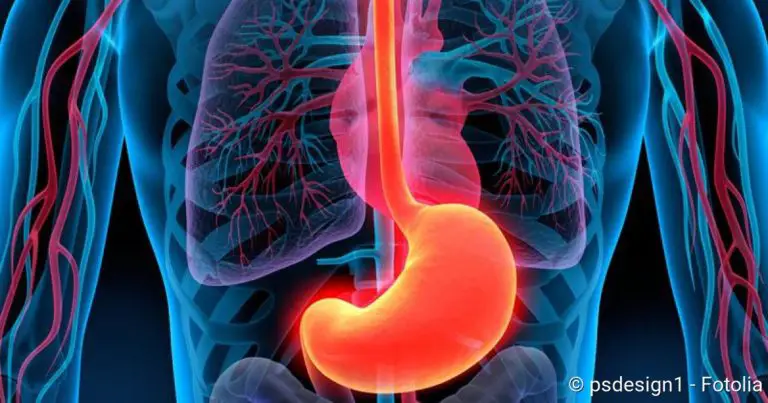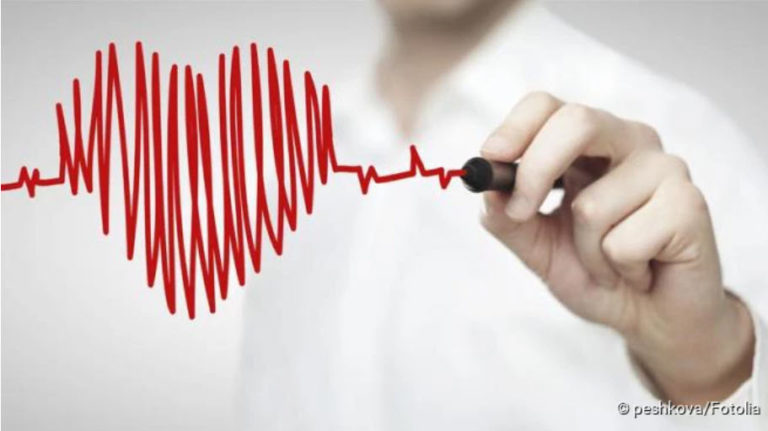Cirrhosis of the liver: description, symptoms, treatment options
Cirrhosis of the liver: description, symptoms, treatment options

Brief overview
- Description: In cirrhosis of the liver (shrunken liver), increasingly healthy tissue is transformed into functionless connective tissue (scar tissue). The liver is less and less able to fulfil its important tasks.
- Symptoms: general complaints (such as fatigue, lack of appetite, weight loss), signs of hepatic skin (reddened palms and soles of the feet, itching, yellowing of the skin and the white dermis in the eye, etc.), often also complications (dropsy, etc.)
- Causes: usually alcohol abuse or virus-induced inflammation of the liver (hepatitis). Sometimes also other diseases of the liver, bile ducts, heart, metabolic diseases etc. or drugs or toxins
- Treatment: Cause must be eliminated/treated. In this way the progression of the disease can be stopped. Already existing liver damage cannot be reversed.
- Prognosis: It depends on how far advanced the cirrhosis of the liver is and whether the cause can be eliminated/treated.
What is cirrhosis of the liver?
In cirrhosis of the liver (shrunken liver), liver tissue perishes and gradually transforms into connective tissue (scarring). Possible triggers are liver damage caused by alcohol abuse, inflammation of the liver (hepatitis) or other diseases.
Due to the increasing conversion of liver tissue, organ function decreases. In the final stage of liver cirrhosis, the liver can no longer adequately fulfil its tasks as a central metabolic organ: The patient dies as a result of the breakdown of all liver functions (acute liver failure).
Cirrhosis of the liver: symptoms
Cirrhosis of the liver causes various general symptoms such as fatigue, lack of appetite or nausea. There are also signs of the underlying disease. If the liver damage is more advanced, specific symptoms of liver cirrhosis also occur.
General symptoms of liver cirrhosis
Cirrhosis of the liver initially shows no symptoms at all or manifests itself with general disease symptoms such as:
- Fatigue and poor performance
- Loss of appetite
- Nausea
- Weight loss
- Bloatedness of the upper abdomen
Cirrhosis of the liver: symptoms of the underlying disease
In addition, symptoms of the underlying disease, i.e. the actual cause of liver cirrhosis, often appear. Signs of the copper storage disease Wilson’s disease, for example, are memory disorders, tremors and psychoses.
Specific symptoms of liver cirrhosis
Liver cirrhosis in the later stages is accompanied by specific signs of liver damage: the liver may be enlarged or reduced in size, rough or bumpy due to the scar tissue that forms. The majority of patients also have an enlarged spleen. A simultaneous enlargement of the spleen and liver is called hepatosplenomegaly.
Further signs of liver cirrhosis are the so-called hepatic signs:
- Yellowing of the sclera of the eyes and the skin (jaundice = icterus)
- “spider naevi’ means small, visible branches of blood vessels that spread in a star or spider shape (particularly on the face and décolleté)
- Reddening of the palms of the hands (palmarerythema) and the soles of the feet (plantarerythema)
- Corner of the mouth rhagades (painful cracks in the corners of the mouth) as well as varnished lips (conspicuous red-glossy lips)
- Itching
Hormonal disorders also occur: When damaged, the liver is no longer able to properly break down the female sex hormones (estrogens), among other things. This can cause the following symptoms of liver cirrhosis:
- Men: Breast development, loss of abdominal hair (belly baldness), shrinking of the testicles, decrease in sexual desire or potency
- Women: Absence or irregularity of menstruation
Cirrhosis of the liver: signs of complications
In advanced cirrhosis, the liver is no longer able to compensate for the large loss of functional cells. This decompensated liver cirrhosis can cause various complications. These include ascites, portal vein hypertension, hepatocellular carcinoma and hepatic brain disease (hepatic encephalopathy). Often varicose veins also develop in the oesophagus (esophageal varices).
Such complications cause additional symptoms of liver cirrhosis:
Abdominal dropsy: Abdominal dropsy (ascites) very often occurs in advanced stages of liver cirrhosis. The accumulation of fluid causes the abdominal girth to increase and the abdomen to bulge. When lying down, the fluid in the abdomen expands to the sides. If it presses on the diaphragm, breathing problems can be added.
Portal vein hypertension: The portal vein collects the blood of various abdominal organs (stomach, intestines, spleen, etc.) and brings it to the liver. In patients with liver cirrhosis, this blood can accumulate in front of the scarred liver. Then a portal vein hypertension develops (portal hypertension). Possible consequences include varicose veins in the oesophagus (esophageal varices: see below) or stomach, which can burst and cause dangerous bleeding.
Liver cell cancer: Liver cell cancer (hepatocellular carcinoma) can manifest itself through pressure pain in the right upper abdomen. However, complaints do not always occur in the early stages. Therefore, all patients with liver cirrhosis are examined for liver cell cancer as a precautionary measure.
Hepatic encephalopathy: Hepatic encephalopathy is the most important complication of liver cirrhosis. About 70 percent of those affected show signs of a disturbance in brain metabolism. The main cause is an increase in toxins such as ammonia in the blood, because the detoxification function of the liver is too weak. Hepatic encephalopathy is divided into four stages depending on the symptoms that occur:
- Stage 1: The sufferers are somewhat drowsy, slightly slowed down in their reactions and slightly confused. Mood swings, lack of concentration and slurred speech also occur.
- Stage 2: The drowsiness increases. In addition, the patients appear apathetic, have shaky hands (tremor), and their writing changes.
- Stage 3: The patients sleep a lot, but can be woken up. Excitement (agitation), aggressiveness and changes in electrical brain activity (EEG changes) are further signs at this stage.
- Stage 4: Due to the failure of the liver, the patients fall into a coma (coma hepaticum). They no longer react to pain stimuli, no longer show reflexes, and the air they breathe has a typical sweetish smell (Foetor hepaticus).
Oesophageal varices
Cirrhosis of the liver can lead to the formation of varicose veins (varices) in the oesophagus. This is because the veins in the oesophagus then serve as a substitute route for large quantities of venous blood on the way from the abdominal cavity to the heart. These esophageal varices initially cause no symptoms.
But it becomes dangerous when the oesophageal varicose veins burst. The so-called esophageal varicose vein bleeding can lead to life-threatening blood loss and can manifest itself, among other things, in haemoptysis. If the patient aspirates this blood into the respiratory tract, there is a risk of suffocation or severe pneumonia. In addition, the blood can enter the intestines via the stomach and colour the stool black. Doctors refer to this as tarry stools.
A varicose vein bleeding in the esophagus is life-threatening and must be treated immediately by a doctor!
You can read more about this topic in the article Esophageal varices.
Cirrhosis of the liver: therapy
The progression of liver cirrhosis can be stopped if the cause is eliminated in time. With the right treatment, the complaints can also be alleviated. However, damage that has already occurred remains – it can no longer be reversed.
A liver cirrhosis therapy consists of several components:
The patient must avoid substances that are harmful to the liver. This includes first and foremost alcohol. Abstaining from alcohol is not only for patients with alcohol-induced cirrhosis of the liver, but also for everyone else! The doctor can give tips and possibilities for alcohol withdrawal (advice centres, therapy centres etc.). Patients should also seek support from relatives, friends and/or support groups (such as Alcoholics Anonymous).
Drugs also damage the liver: they should therefore only be taken in cirrhosis of the liver if medically necessary. In addition, patients should always consult their doctor first before using any preparations on their own – including over-the-counter medicines and dietary supplements.
Every liver cirrhosis therapy also includes treating the triggering underlying disease (as much as possible). For example, the doctor prescribes certain drugs for inflammation of the liver (hepatitis).
The targeted treatment of complications is also very important. For example, diuretics help to flush out the accumulated fluid in cases of abdominal dropsy. In addition, those affected should follow a low-sodium diet. In severe cases of abdominal dropsy, a so-called puncture may be necessary: The doctor inserts a thin needle into the abdomen to drain the fluid through a tube.
In cases of severe, advanced liver cirrhosis, a liver transplant is often the patient’s last chance.
Cirrhosis of the liver & nutrition
In general, doctors recommend a balanced, vitamin-rich diet for cirrhosis of the liver. If there are no complications and the patient’s nutritional status is normal (neither overweight nor underweight), a special “liver diet” is not advisable. If a special diet is necessary, the attending doctor will discuss this with the patient.
For example, overweight patients with a fatty liver should eat a low-fat and calorie-reduced diet. This helps with weight loss (together with regular exercise).
If the liver damage already disturbs brain functions (hepatic encephalopathy), it is particularly important to reduce toxins in the blood. To this end, those affected should eat less protein – then less toxic ammonia is also produced in the body. In addition, the elimination of this toxin can be promoted with lactulose, a light laxative.
The following also applies to all other patients with liver cirrhosis: You should ensure a regular bowel movement to support the excretion of toxins through the intestines. Diets rich in fibre and a sufficient supply of liquid help here. Patients should discuss with their doctor which amount to drink per day is sensible and advisable. In certain cases, one should not take in too much fluid, for example in cases of dropsy.
Cirrhosis of the liver: causes and risk factors
Various diseases can lead to cirrhosis of the liver as a late consequence. In industrialized countries, alcohol abuse is present in more than half of all cases of cirrhosis of the liver. In the remaining patients, cirrhosis of the liver can be attributed to inflammation of the liver (hepatitis B or hepatitis C) or (more rarely) another disease. Sometimes it is also caused by medication.
Cirrhosis of the liver due to alcohol
Long-term alcohol abuse is one of the skin causes of liver cirrhosis in Germany. Doctors also refer to this as ethyltoxic cirrhosis of the liver.
As the central metabolic organ, the liver is responsible for breaking down the large amount of alcohol. Toxins are increasingly produced in the process. First of all, they cause the liver to store a pathological amount of fat – a so-called fatty liver is formed. At this stage, the changes in liver tissue are still partially reversible.
If the excessive alcohol consumption continues, the cells overloaded with fat will die. They are replaced by connective tissue (scar tissue). Doctors then speak of liver fibrosis. The development of the scar and connective tissue is irreversible. If the fibrosis progresses further, cirrhosis of the liver finally occurs.
The amount of alcohol that leads to cirrhosis of the liver varies greatly from person to person. In general, the daily consumption of about 40 grams of alcohol alone can cause irreversible damage to the liver in men. Women react more sensitively to the poison. Even 20 grams of alcohol per day can therefore cause permanent liver damage.
More than 30 percent of all cases of liver cirrhosis in Germany are caused by chronic liver inflammation (hepatitis) of type B or C. Both forms of the disease – hepatitis B and hepatitis C – are each triggered by a particular type of virus. These viruses are found in practically all body fluids such as blood, semen, urine or saliva in infected persons.
Over time, the chronic inflammation can damage the liver cells to such an extent that they die and scar – liver cirrhosis develops.
Other causes of liver cirrhosis
Other causes of cirrhosis of the liver can be
- Liver and bile diseases: e.g. immune-related inflammation of the liver (autoimmune hepatitis), chronic inflammation of the small bile ducts in the liver (primary biliary cirrhosis/cholangitis, PBC), chronic inflammation and scarring of the middle and larger bile ducts (primary sclerosing cholangitis, PSC)
- Metabolic diseases: Iron storage disease (hemochromatosis), copper storage disease (Wilson’s disease), cystic fibrosis etc.
- Tropical diseases such as bilharzia or liver fluke infestation
- Heart diseases such as chronic right heart failure (right heart failure)
- Toxic substances such as carbon tetrachloride or arsenic
- Drugs like methotrexate (for cancer and autoimmune diseases)
In some cases no cause for the disease can be found. Then there is a so-called cryptogenic cirrhosis of the liver.
Cirrhosis of the liver: examinations and diagnosis
The doctor will first take the patient’s medical history (anamnesis). He will have the symptoms described in detail and ask about any pre-existing or underlying diseases. A possible hepatitis infection is particularly important. The doctor also asks whether the patient is using any medication and how much alcohol he or she is consuming.
Physical examination
The next step is a physical examination if cirrhosis of the liver is suspected. The doctor palpates the size of the liver and spleen as well as the edge of the liver. He also taps the abdomen to determine whether there is fluid in the abdominal cavity (ascites).
An important indication of liver cirrhosis is also the so-called hepatic signs. The doctor checks, for example, whether the palms of the hands are reddened (palmarerythema), “vascular spiders” (spider naevi) or the patient has jaundice (icterus).
Blood test
The extent of the liver damage can be determined by a blood test. If the following values are reduced, this indicates that the liver is no longer working so well:
- Albumin
- Cholinesterase (CHE)
- Coagulation factors II, VII, IX, X (this reduces the quick-value, i.e. it takes longer for the blood to clot)
The following values may be elevated in liver cirrhosis:
- Bilirubin
- Ammonia (for hepatic encephalopathy)
- the liver enzymes GOT (ASAT), GPT (ALAT), GLDH and Gamma-GT
Imaging methods
Using ultrasound (sonography), the doctor can assess the size and condition of the liver. It can also be used to determine portal vein hypertension. Sometimes the doctor also uses a special ultrasound technique – Doppler sonography. Another special form of ultrasound (fibroscan) shows how much the liver is already scarred.
A computer tomography (CT) is only necessary if the ultrasound findings are unclear.
In order to detect the structural transformation into scarred connective tissue, the doctor takes a tissue sample (biopsy) of the liver and sends it to the laboratory for analysis.
Further investigations
Sometimes further examinations are indicated. For example, gastroscopy is often recommended for newly discovered liver cirrhosis. The doctor can detect varicose veins in the oesophagus or even in the stomach.
For the clarification of a slight brain damage caused by cirrhosis of the liver (hepatic encephalopathy), so-called psychometric tests can be performed, among other things.
Stages of liver cirrhosis: Child-Pugh-Score
Cirrhosis of the liver can be divided into different stages. To do this, physicians use the so-called Child-Pugh-Score: It takes into account five criteria that give an indication of how advanced the shrunken liver is. The Child Pugh criteria are:
- Abdominal dropsy (ascites), evaluated in ultrasound
- Brain damage caused by liver disease (hepatic encephalopathy)
- Albumin concentration in the blood: Albumin is a protein that is produced in the liver. Less albumin is produced in cirrhosis of the liver.
- Bilirubin concentration in the blood: Bilirubin is a breakdown product of the blood pigment haemoglobin. Normally it is further broken down in the liver. In cirrhosis of the liver, it accumulates in the blood.
- Quick value: This marker for blood clotting is dependent on coagulation factors produced in the liver. In cirrhosis of the liver fewer clotting factors are formed. This reduces the Quick value. Alternatively, blood coagulation is often described today with the INR value: It behaves in reverse to the Quick value (e.g. high Quick value, low INR).
The doctor checks each criterion with the patient and assigns points:
| Criterion | 1 point | 2 points | 3 points |
| Albumin (g/dl) | > 3,5 | 2,8 – 3,5 | < 2,8 |
| Abdominal dropsy | none | little | distinctive |
| Bilirubin (mg/dl) | < 2,0 | 2,0 – 3,0 | > 3,0 |
| hepatic encephalopathy | none | medium | distinctive |
| Quick value (%) or INR | > 70 % or < 1,7 | 40 – 70 % or 1,7 – 2,3 | < 40 % or > 2,3 |
If liver cirrhosis is caused by primary biliary cirrhosis, the bilirubin level is assessed differently: For measured values below 4 mg/dl 1 point is assigned. If the bilirubin level is between 4 and 10 mg/dl, you get 2 points. For bilirubin levels above 10 mg/dl, the doctor awards 3 points.
Cirrhosis of the liver stages
The Child-Pugh-Score is the sum of all achieved points. It is between 5 and 15 points: Cirrhosis of the liver of the mildest severity results in a score of 5, whereas severe liver damage results in a total score of 15.
The individual ranges of points are assigned to different stages of liver cirrhosis: With a total score of 5 to 6, Child A liver cirrhosis is present – the mildest stage of liver cirrhosis. Child B corresponds to a Child Pugh score of 7 to 9, whereas the scores 10 to 15 indicate the highest stage of liver cirrhosis: Child C.
Based on the stage, the doctor can estimate the patient’s risk of death for the following twelve months:
| Child-Pugh-Score | Stadium | 1-year mortality |
| 5 – 6 | Child A | 3 to 10 per cent |
| 7 – 9 | Child B | 10 to 30 per cent |
| 10 – 15 | Child C | 50 to 80 per cent |
As the table shows, the mortality rate in the first year at Child A stage is still quite low. However, it increases significantly with further progression of the liver cirrhosis.
Cirrhosis of the liver: course of the disease and prognosis
The earlier liver cirrhosis is detected and treated, the better the prognosis. Effective treatment includes eliminating or treating the cause of the disease (alcoholism, hepatitis, etc.). For example, alcoholics who stop drinking permanently have a comparatively good prognosis for liver cirrhosis. However, the damage already caused is not curable. Only the progression of cirrhosis can be stopped.
The prospects are significantly worse if people with alcohol-related cirrhosis of the liver continue to drink alcohol. Every second one of them then dies within five years. However, complications of cirrhosis of the liver can additionally worsen the life expectancy of patients.
The most frequent causes of death in patients with liver cirrhosis are liver failure, bleeding from varicose veins in the esophagus or stomach, and liver cancer (hepatocellular carcinoma).
Cirrhosis of the liver: prevention
If you want to prevent cirrhosis of the liver, you should first and foremost avoid alcohol or at least consume it in moderation: Healthy men can drink up to 0.75 litres of beer or three eighths of a litre of wine a day. Healthy women are recommended a maximum of 0.5 litres of beer or a quarter litre of wine. For both sexes applies: This “permitted” amount of alcohol should not be allowed every day!
With a hepatitis vaccination you can prevent the second most common cause of liver cirrhosis. Such a vaccination is advisable especially before planned trips abroad.
Pay attention to toxic chemicals in the workplace (carbon tetrachloride, benzene, etc.): company doctors or occupational health physicians will inform you about possible dangers and occupational safety measures.
Only take medication and vitamin supplements when necessary. As the central metabolic organ, the liver must break down and detoxify all foreign substances. Ask your doctor or pharmacist in advance how liver-damaging a preparation is – perhaps there is a better-tolerated preparation that does not increase the risk of liver damage and cirrhosis.




